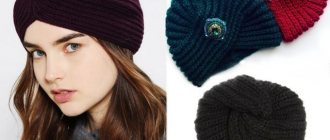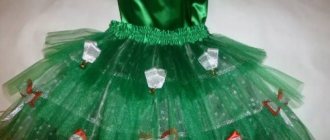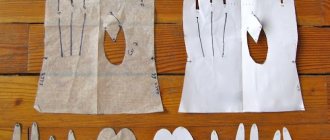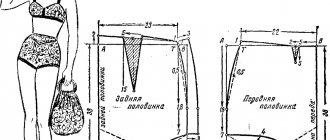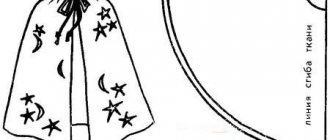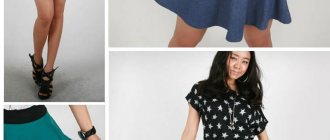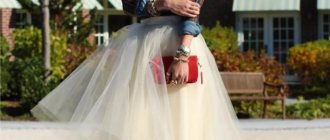| Dress patterns |
| The sundress pattern with wide straps is intended for cutting and sewing from thick fabrics. Pieces can be cut from cotton, wool and well-draped linen. |
| Dress patterns |
| At the end of the article you will download a simple and beautiful pattern for a long knitted dress. The construction is also suitable for other elastic fabrics. |
| Dress patterns |
| Especially for beginners, our website with patterns has prepared a new model - a dress with one-piece sleeves. The pattern is simple, with a dart on the back. Darts are perhaps the only complicating element. |
| Dress patterns |
| Especially for you, we have added a new pattern to the site - a dress without sleeves and lining. This simple model is built without darts so that every beginner can master sewing. |
| Dress patterns |
| Sheath dress pattern for sizes 42, 44, 46, 48, 50. The dress has long sleeves, a V-neck and piping. |
| Dress patterns |
| A new and very simple pattern for a summer dress made of knitwear. The dress has a floor length, V-neck, sleeveless, piping at the neckline and armholes, one-piece straps, sizes 44, 46, 48, 50, 52. |
| Dress patterns |
| We invite you to download a pattern for a summer dress with short sleeves. The sleeves are constructed in an original way; they are one-piece with yokes. The front and back barrels are one-piece with lower sleeve details. |
| Dress patterns |
| A simple dress pattern specially prepared for overweight women. The dress is cut with short sleeves, there are chest darts on the front to give the desired shape, a button fastening on the back, and the neckline is finished with piping. |
| Dress patterns |
| The simple tunic pattern is made with sleeves. You can use a sleeveless pattern. The armhole sections in this version are overstitched and hemmed. |
| Dress patterns |
| The long sleeve dress pattern should appeal to all lovers of home sewing. Convenient and easy to sew, the model can be sewn in just a couple of hours. The ideal fabrics for a long sleeve dress are, of course, knits and jersey, although other stretchy fabrics will work as well. |
| Dress patterns |
| Soon it will be time to take care of your New Year's outfit, so we decided to once again remind all sewing lovers about the models of evening dresses, patterns of which can be downloaded on our website. The advantage of our models is that they are made in full size. |
| Dress patterns |
| The new summer dress pattern is designed for women in sizes 40, 42, 44, 46, 48 and 50. One easy-to-sew pattern varies in length and shoulder design, allowing you to cut five long and short dresses from one pattern. |
| Dress patterns |
| Here is a photo of a really beautiful dress. What makes it so? The combination of several details makes it so. A pattern for a dress with a semi-sun skirt, the design of which is complicated by pockets and folds. The look turned out interesting, and the sewing was simple. This dress has a low neckline, and very original pleated straps give it a completely unique look. |
| Dress patterns |
| New Year's dress is a type of evening dress. Sometimes cocktail dresses suitable for dance parties are recommended for New Year's Eve, but a floor-length dress is considered a classic option. |
| Dress patterns |
| Dresses for plus size people come in two types - those that hide figure imperfections and, we offer you to download the pattern of just such a model, which exactly repeats the design of dresses for women of small sizes. The dress that you can see in the photo is built according to the principles of clothing in small sizes, which assumes the presence of the correct figure. |
| Dress patterns |
| A pattern for a summer dress made of chiffon, sleeveless, with a fitted bodice, with a cut-off widened skirt at the bottom, with a zipper in the back middle seam, lined. Sizes 40, 42, 44, 46, 48. |
| Dress patterns |
| A dress pattern made of knitwear of a simple design, a fitted style, with straps, sleeveless and collarless, with edging at the armholes and neckline, sizes 42, 44, 46, 48, 50, 52. |
| Dress patterns |
| The long sleeve long dress pattern is made specifically for knitwear or jersey. Woolen knitwear with some fancy or foliage-floral pattern is also suitable for dresses. For sewing, use an overlocker or other chain stitch machine. This is necessary so that the stitches do not burst when stretched. |
| Dress patterns |
| Knitted sheath dress with edging at the armholes and V-neck, with darts on the front and back, and a zipper in the side seam. Sizes 40, 42, 44, 46, 48, 50. |
| Dress patterns |
| Lately we have been devoting a lot of time to evening and elegant dresses. This is not surprising, because you, dear home sewing enthusiasts, are constantly asking about them. One such dress for just one evening can help you forget about years of jeans and office dress code. |
| Dress patterns |
| The dress pattern with straps and a fitted silhouette is cut from elastic fabrics. In fact, this is a slightly modified sheath dress pattern; in this model, the bodice and sleeves are cut off. |
| Dress patterns |
| It is no coincidence that we have a pattern for a red dress. Red is the color of passion, irrepressible desire, challenge. This model can only be sewn in this color. |
| Dress patterns |
| It is no coincidence that the cocktail dress is very popular, especially among young girls and women. This is a beautiful and elegant dress, without which you cannot imagine a single holiday, and most importantly, the variety of styles and models allows us not to repeat ourselves and always be different from each other. |
| Dress patterns |
| Tunics are good because they are very quick and easy to sew and can be used as a home dress. This model of tunic differs only in the loops for the belt or strap; otherwise, all operations are simple. |
| Dress patterns |
| A transformable dress is the dream of many women. Indeed, one pattern allows you to get so many models that it takes your breath away. The highlight of the dress is the ties, which allow you to create such variety. |
| Dress patterns |
| We all want to keep up with the times and fashion, but it’s even nicer to be ahead of them. And for those who want to get ahead of their time, we offer a special dress pattern , which, according to all forecasts, will be the most popular and fashionable in the new 2015. |
Source: https://all-vykrojki.ru/vykrojki-platev
DIY linen dress: ideal for summer
The popularity of linen dresses continues to grow every year. Almost every woman has products made from this fabric in her wardrobe. Many ladies, striving for individuality, prefer to sew a linen dress with their own hands. Why is this material so loved by fashionistas? Linen dress is suitable for women of all ages and sizes; there are many options for models.
Linen is an ideal fabric for hot weather because it gives a feeling of maximum comfort due to its natural composition, which perfectly allows air to pass through without causing skin irritation and providing a high degree of thermoregulation.
The undeniable advantages of clothing made from linen fabrics:
- provides skin protection from ultraviolet rays;
- the fabric does not cause allergies;
- the natural composition has an antiseptic effect, which blocks the appearance of an unpleasant odor;
- the fabric dries quickly;
- absolutely not electrified;
- has high wear resistance and does not deform, easily restores its shape after washing.
Required materials and tools
If you still decide to sew a dress without a pattern quickly, simply and stylishly from linen, then you should know what tools and materials you will need. Linen is probably ideal for creating any clothing.
You might be interested in Sewing rules and creating a unicorn pattern
Note! Before starting work, such material requires mandatory decatification.
Also, to avoid skewing the model, it is worth basting the material along the edges, or stitching it together. It is not recommended to use the spinner to avoid creases. It is better to iron linen slightly damp before sewing. Also use steam when ironing.
Sewing tools
Important! The allowances should be left significantly larger than for other fabrics.
Otherwise, the set of tools for a linen dress and pattern is standard: scissors, fabric, chalk for transferring the pattern, scissors, needles, threads, sewing machine, tape for taking measurements, pins.
DIY summer dress - Zigzag
Natural linen has unique properties: it cools in hot weather and has an antibacterial effect on the skin. Therefore, linen fabrics are ideal for sewing summer clothes.
It is better to choose a simple style with a loose fit, because linen wrinkles and stretches very much during wear.
Our master class describes how to sew a bright linen summer dress with a loose fit with a deep neckline at the back, and also decorate it using gold acrylic paint.
When purchasing linen, you should definitely be interested in the exact composition of the fabric, since blended fabrics with a high cotton content and the addition of artificial fibers are often on sale, which significantly changes the quality and properties of the fabric. Before cutting, linen should be washed in warm water and steamed well with an iron so that the fabric shrinks.
To sew a dress 84 cm long you will need:
— natural linen fabric 1 m. with a width of 1.5 m.; — thin natural lining fabric made of cotton 0.4 m, 1.5 m wide; - threads in the color of linen and lining fabric; - doublerin; — paint for natural fabrics in gold color; - brush; - masking tape 4 cm wide; - scissors; - ruler; - pins;
- a pencil or a piece of soap.
Sew a dress
As a basis for the dress, you can take the pattern of a straight sleeveless dress of a suitable size. Fold the fabric in half with the right side inward along the grain thread, departing 0.35 m from the edge.
Pin the front pattern into the fold, widen the bottom of the dress along the side seam by 5-6 cm. You need to start expanding 5 cm above the waist line. Since linen fabrics are loose, it is better to leave an allowance of 1.5 cm, and for hemming the bottom 3 cm .
For the neckline and armholes, 1 cm is enough.
Cut out the back with a middle seam, departing 2 cm from the fold. Expand it in the same way as the front half.
Wash the dress completely and try it on. Adjust the location of the chest darts and mark the waist line. After trying on, fit the dress along the middle back seam by 1.5 cm, as shown in the photo.
Deepen the neck at the back by 12 cm and cut off at an angle.
After modeling, cut out the lining. For a summer dress, don't make it too long. 12 cm below the armhole is enough.
The back can be cut without a middle seam. Make chest darts on pieces made of linen and lining fabric. Smooth them down.
Sew the middle seam on the back. Overlock the edges using an overlocker, including the side and shoulder seams. Unfold the allowances and steam with a hot iron through cotton fabric.
Cut out 1.5 cm wide strips from the doublerin along the grain thread and glue them along all sections of the neckline and armholes so that they do not stretch during wearing. You need to glue the dublerin using an iron without steam through a cotton cloth.
Pin the lining dress pieces face to face. Gently sweep them away, avoiding stretching the fabric. Then stitch along the lines of the neckline and armholes, leaving 3 cm short of the shoulder seams. Cut the allowances to a width of 0.5 cm, make notches along the circumferences.
Fabric selection and care
Although linen curtains are highly durable, they require careful care. It is recommended to wash them at a temperature no higher than +30..+40 °C using soft products for delicate fabrics. It is not advisable to spin the fabric in a centrifuge, otherwise there is a high risk that it will simply shrink after washing.
A serious disadvantage of linen, like other natural fabrics, is the difficulty of ironing.
To ensure that such curtains always look flawless, as in the photo on the Internet, you will have to work hard. Therefore, do not leave the curtains just hanging after washing - they must be ironed with a very hot iron while they are still damp. And if you don’t want to bother with such a capricious material, to sew curtains with your own hands, you can choose a wrinkle-resistant mixed fabric with the addition of lavsan.
Pure flax is not only difficult to care for, but is also expensive. This problem can also be solved - just buy fabric with added cotton. Its price is significantly lower, the fabric itself is lighter and more airy, although its service life is noticeably reduced due to less resistance to wear.
How to sew a linen dress yourself
Linen clothing is comfortable in any weather and looks trendy thanks to the trendy, “natural” texture of the material. The natural composition of the fabric helps maintain proper moisture and air exchange and ensures optimal thermoregulation.
Even in a thick outfit you will be warm on a cool day and not stuffy in the room. Linen is suitable for people with sensitive, allergy-prone skin. It is hygroscopic and reduces the risk of irritation.
Clothes made from natural materials, modern practical fabrics with the addition of viscose, cotton, are suitable for children.
Features of linen fabric:
- does not electrify and helps protect the skin from ultraviolet radiation;
- dries quickly after washing;
- wear-resistant - dresses retain their original appearance for a long time even with constant use;
- has antiseptic properties (linen suture material is used in medicine).
livemaster.ru
Finishing linen fabric has the same advantages - sewing, which is often used to decorate dresses. To make things wrinkle less, modern synthetic threads are added to the natural composition.
When sewing linen products, you must follow the rules for working with the material:
- Before cutting things, linen needs to be decated: soak it in warm water (the fabric is washed at +30-40°C), dry it and dry it with an iron in steam mode;
- Do not use hot water (temperature above +40°C), otherwise the material will shrink greatly;
- When modeling patterns, you need to follow the dimensions very accurately, since natural linen materials do not stretch;
- thin summer fabric is see-through - if you don’t like it, use linings;
- When sewing, pay attention to the processing of seams and cuts - they fray a lot on linen fabrics.
The fabric is ironed slightly damp, and washed linen clothes are dried flat.
siniylen.ru
Popular styles and basic patterns
You can sew a dress in popular styles from linen.
The material has the following characteristics: it holds its shape “rigidly” and is inelastic, so it is most suitable for designing:
- classic straight or loose sundresses for summer;
- formal sheath dresses for the office or cocktail reception;
- shirt-type models - universal, with or without a belt;
- loose-fitting ethnic clothing;
- models with a wraparound, asymmetrical cut;
- semi-fitted, fitted dresses with full skirts;
- dresses in boho style - a mixture of bohemianism and romance.
In addition to the usual neutral, restrained shades, bright colors of linen fabrics are increasingly being used - coral, blue, yellow. They are suitable for a romantic look and summer outfit. Contrasting lace, knitted or linen, sewing, appliqués, prints, braid or buttons are used as decoration.
If you choose the right finish and size to suit your figure, even a laconic hand-sewn linen dress will be elegant and will decorate you. A typical basic pattern consists of:
- one middle part of the shelf with a fold;
- two side parts of the shelf;
- two middle parts of the back (if you do not need to save material, fold it);
- side back;
- sleeves;
- 8 strips that are cut on the bias - 3.5x40 cm.
livemaster.ru
Sewing a basic dress
Traditional simple styles go well with the “natural” texture of linen and products made from them look organic. If you are going to sew a two-layer dress, in addition to the main fabric (for a knee-length dress you need about 2 meters), you will also have to look for lining material - for example, cotton.
You will also need:
- threads to match the fabric, dublerin;
- elastic bands for sewing into products;
- paper, ruler, pencil (chalk, disappearing marker) for the pattern;
- scissors, pins, needles;
- sewing machine, overlock;
- iron.
The basis is a straight-shaped dress pattern, with a V-shaped neckline at the back and a neat round neckline. The canvas is folded in half, face inward, guided by the grain thread and retreating 35 cm from the edge. Pin the front drawing into the fold, and then start expanding the bottom from the waist axis plus 5 cm up.
The back is cut with middle seams and widens similarly to the front. Next, the product is basted and needs to be tried on in order to correctly position the darts on the chest and waistline.
After adjustment, the dress is fitted at the back (middle seam), and the neckline at the back is deepened to make a beautiful V-neck and cut at a sharp angle.
smartshopper.ru
After cutting out the lining (it should be 10-12 cm below the armholes), construct the back, make darts on the chest and smooth them down.
Progress
- Sew the middle seam on the back, overlocking the edges and ironing the seam allowances.
- Cut out 1.5 cm strips of dublerin and glue them to the cuts along the neckline and armholes - using an iron on cotton fabric.
- Pin the product with the lining, right sides facing each other, and sweep, making sure that the fabric does not stretch.
- Sew the details along the neckline and armhole, not reaching 3 cm to the seams on the shoulder.
- Cut seams up to 0.5 cm wide, cut along the circumference.
- Sew the seams of the shoulder, turning the parts face out, smoothing out the allowances.
- Sew the shoulders with the lining (from the inside out) and the open parts of the neckline and armhole.
- Join the seams on the sides of the dress and the lining in one line, turning the allowances to the sides and steaming them.
- Overlock the side edges and bottom of the lining, cutting it in a semicircle.
- Pin the lining to the seams at the back and sides.
- Turn out the neckline and armholes (they need to be steamed), sweep away the lining and facing material.
What are we sewing?
Dresses
It is in dresses that all the charm of linen fabric is revealed. They fit perfectly and look great. The most important thing for the summer months is that such clothes are light and pleasant to the body. Due to its strength, the material holds its given shape well and is suitable for the fair sex of all ages. Open sundresses, shirt dresses or strict sheaths - designers are creative in creating linen models.
Linen clothes often come with roomy pockets, so you can easily go for a walk without a handbag - your keys and phone will always be with you. Dresses of any length - from incredible minis to elegant maxis - look impressive, do not restrict movement and prevent overheating on hot days. You can diversify the natural color of the fabric with the help of elegant ethnic embroidery. A distinctive feature of linen fabric is that it does not fade or fade in the sun.
Shorts and trousers
Perhaps the most popular linen products. In such clothes you will be comfortable both on a walk and at a business meeting. You can experiment with the cut and instead of straight trousers, sew a model that is loose at the hips with arrows, or comfortable trousers with a drawstring.
Jumpsuits
Jumpsuits are still trending and look set to stay in style for a long time to come. Models of different styles and styles will look stylish. Muted and bright colors - you can choose any. This item is a must have in your summer wardrobe.
Blouses and jackets
Comfortable and elegant linen blouses or a light summer coat – the variety of models is amazing.
Linen clothes are perfect for wearing in the office, combined with jackets and blazers, and thanks to mixed types of fabrics, blouses will wrinkle less and fit exactly to your figure.
Sewing linen clothes yourself is quite simple. It is only important to remember about the possible shrinkage (up to fifteen percent) and sharpen the scissors in time - due to the high density of the fabric, the sharp blades quickly become dull and begin to spoil the material. You can buy linen in any colors with different prints at the Textiles fabric store. You can fill out an application through the form on the website or by phone: +7-800-500-3933.
DIY linen dress
The linen dress is again gaining momentum among modern fashionistas who love to do things with their own hands. This is not at all surprising, because such a natural material as linen is perfect for everyday wear.
Linen material is especially good for hot summer days. Compared to cotton fabrics, linen will help reduce your body temperature by three to four degrees during the summer heat.
How to sew a linen dress with your own hands: advantages and disadvantages of the material
To sew dresses for plus size people, linen is used as the main material, and cotton material “sewing” is used as finishing. These two materials are of natural origin and have been known for a very long time. These materials are very well suited for hot summer days.
The main and undeniable advantage and advantage of flax is its naturalness. Environmentally friendly flax fibers are even used in the medical field as suture material.
Another positive property of linen material is its antiseptic ability.
Linen material promotes antiseptic effects, prevents the reproduction and development of negative microflora, infection, bacteria and fungal flora.
This material, popular among fashionistas, perfectly and quickly absorbs and releases moisture and does not cause allergic reactions in the body. Also, linen items contribute to better thermoregulation of the body and keep cool well even on the hottest days.
Linen is a fairly durable material, wear-resistant and does not electrify, and has good breathability.
However, despite the large number of advantages of linen material, it still has disadvantages. The disadvantages of such a popular natural material include its high shrinkage when washed at high temperatures. It is for these reasons that linen products are recommended to be washed at 30-40 degrees.
Linen also wrinkles quite a lot with constant wear. That is why the products should be dried in a straightened state, and ironed slightly damp.
Also, when sewing products from linen, it is necessary to carefully process the cuts and seams, since linen frays very much.
However, all of the above disadvantages are minor and easily removable. By sewing a product from linen, you will get a very strong and durable model.
We bring to your attention a detailed description of the process of designing and sewing a linen dress with a sheath silhouette. You can see an example of the model in the photo below.
The features of this dress design model are as follows:
- The length of the finished product will be up to the middle of the knee.
- The neckline will be slightly wider at the shoulder and deeper.
- Features of the sleeve structure: made of finishing “sewing”, set-in and short.
- The zipper of the dress will be located on the left side.
- There will be a slot in the center of the back panel of the skirt.
- On the shelf above the strapless line there are multidirectional inclined reliefs, dividing the shoulder area into details made of linen and “sewing”.
- At the back is the central part of the bodice between the reliefs. The cut-off part just below the waist is divided into two parts made of different materials.
- The upper part at the neck will be made of the main fabric. It has a radial drapery intercepted in the center by a spaced strip.
- The side parts of the lower part of the skirt are made of finishing fabric.
- The bottom of the sides of the skirt, the front neckline and the bottom of the sleeves will be finished using an outer hem.
Now you can start sewing a linen dress:
- Connect yokes 6, 7 and 8 together, as well as trim pieces 9 and hem 9a. Iron the seams to part seven and stitch one millimeter with a seam.
- Lay the drapery on the yokes 10. Stitch both parts together.
- Sew the central part of the back three with the yoke ten.
- Finish the vent in the back center seam of the skirt.
- Connect the central parts of the backrest three and four together.
- Sew side seams two and five. On the left side, process the zipper.
- Using undercut 15, work side part 14 onto the face. Sew it to the bottom of the side part.
- Connect the reliefs of the princesses of both panels. Press the seams towards the center and away from the center along the back.
- Connect the shoulder sections. Along the back, we will trim 16 the neckline and partially the shoulder sections.
- Process the bottom of the sleeve by cutting 13 to the face.
- Sew the sleeve into the armhole.
We offer a selection of videos on the topic of the article. We hope that it will be useful and interesting for you. Enjoy watching!
Source: https://sdelala-sama.ru/shityo/3537-plate-iz-lna-svoimi-rukami.html
Pattern in ethnic style
Ethnic style always looks bright, conveying the special mood of the hostess.
Here everything is done by analogy.
- Transfer the patterns to the material. It's better to take a plain one.
- Cut out the pattern pieces. For the top, join the side seams, sew the neckline and bottom. Join the sleeves with one seam, finish the cuffs, and connect them to the base.
- Next is the material for creating an ethnic style. Sew ribbon along the neckline, cuffs and hem.
- Making a skirt is also worth it. Cut out the details. Join the skirt with one seam. Make a belt around the waist and sew it on the skirt.
- Sew ribbon along the bottom and waist to create an ethnic style. If desired, you can use ribbon to create your own patterns or elements.
You might be interested in: Patterning and sewing clothes for bassik with your own hands
Such an interesting costume will confirm originality and refined taste. It's interesting and unusual. It will highlight your waist and attract attention.
Pattern of a summer suit in ethnic style



